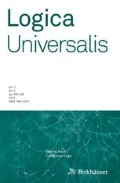Abstract.
This paper aims to highlight some peculiarities of the semiotic square, whose creation is due in particular to Greimas’ works. The starting point is the semiotic notion of complex term, which I regard as one of the main differences between Greimas’ square and Blanché’s hexagon. The remarks on the complex terms make room for a historical survey in Aristotle’s texts, where one can find the philosophical roots of the idea of middle term between two contraries and its relation to notions such as difference, position and motion. In the Stagirite’s non-logical works, the theory of the intermediate, or middle term, represents an important link between opposition issues and ethics: this becomes a privileged perspective from which to reconsider the semiotic use of the square, i.e., its inclusion in the semio-narrative structures articulating the sense of texts.
Similar content being viewed by others
Author information
Authors and Affiliations
Corresponding author
Rights and permissions
About this article
Cite this article
Bonfiglioli, S. Aristotle’s Non-Logical Works and the Square of Oppositions in Semiotics. Log. univers. 2, 107–126 (2008). https://doi.org/10.1007/s11787-007-0021-z
Received:
Accepted:
Published:
Issue Date:
DOI: https://doi.org/10.1007/s11787-007-0021-z




